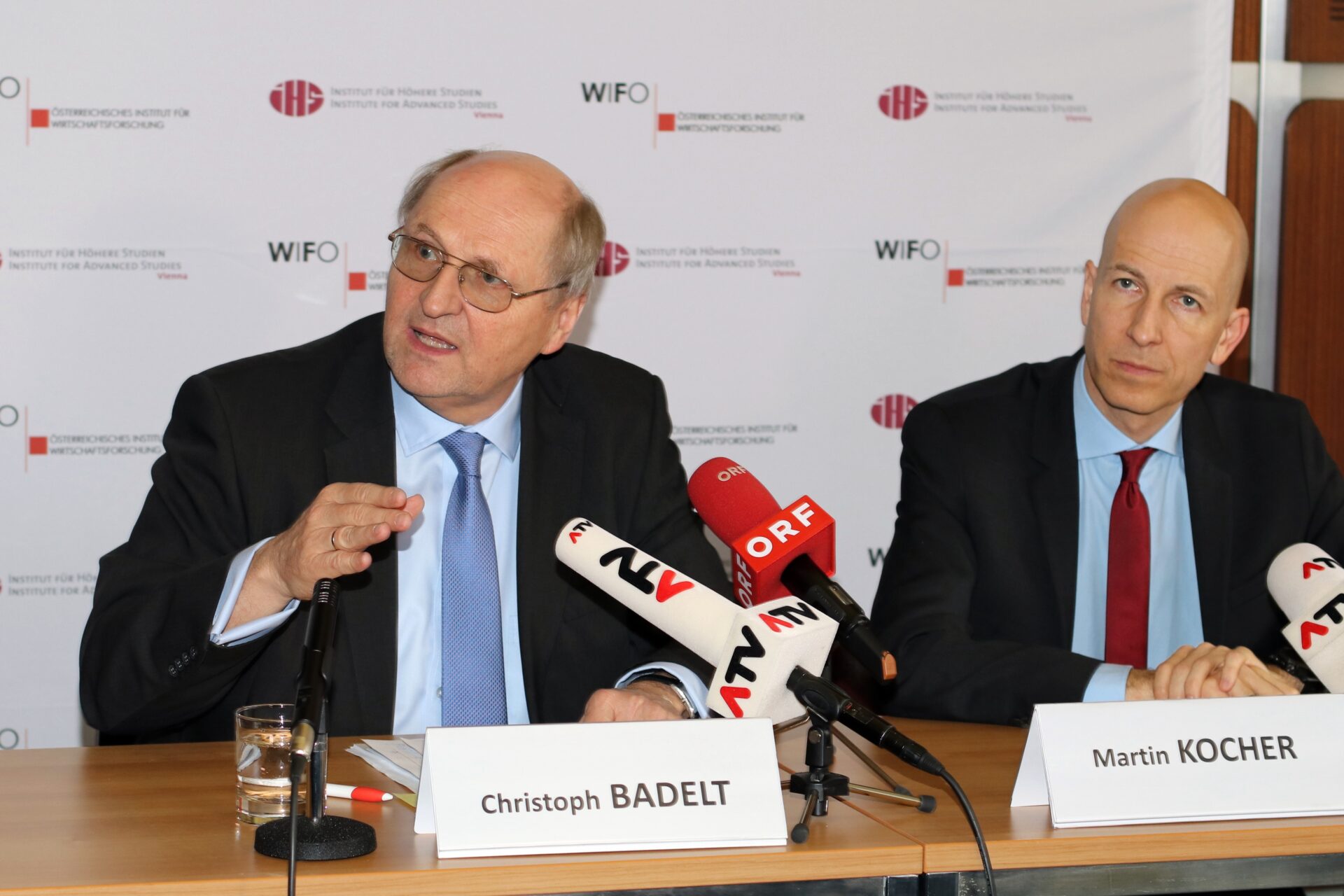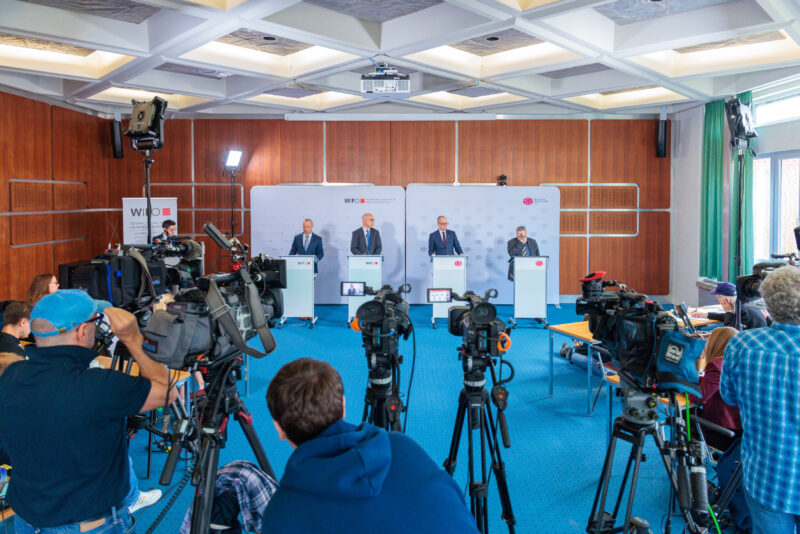
24.03.2017
Economic Outlook for 2017 and 2018: Business Cycle Upswing in Austria
Apart from lively internal demand, foreign trade will rebound and contribute more strongly to GDP growth than in recent months.
From a rate of growth of 1.5 percent in 2016, demand and output in Austria are expected to accelerate significantly in 2017 and 2018. Leading indicators clearly suggest a further strengthening of business activity. In this environment, the Austrian economy is expected to expand by 2.0 percent in the current year and 1.8 percent in 2018.
Austria's economy is enjoying a period of cyclical upswing. Support comes from domestic demand, driven by favourable labour market developments. Exports pick up in step with strengthening aggregate demand on foreign markets. Growth of the US economy is set to edge up notably in 2017, while activity in the euro area should stay on a firm upward path. With prices for raw materials rising on world markets, growth in commodity-exporting countries should regain momentum. Hence, exports should provide a distinctly stronger contribution to Austria's GDP growth than in recent periods, thereby supporting the healthy pace of domestic demand forces.
In this environment of a broad-based upward trend across demand components on the one hand and production across sectors on the other, business activity in Austria is bound to gather momentum. The favourable signs from forward-looking indicators also confirm the prospect of a sustained cyclical upturn over the entire forecast horizon. In the event, real GDP will gain 2.0 percent in the current year and 1.8 percent in 2018, exceeding in both years the rate of potential output growth. While overall productive capacity will likely be extended with the increase in demand and output, the output gap will still be negative by the end of 2018. The implicit dampening impact on inflation should nevertheless ebb and upward pressure on prices may gradually mount. After an annual increase of 0.9 percent in 2016, the consumer price index (CPI) is projected to climb by 1.7 percent each in 2017 and 2018. Oil price volatility remains a risk, notably for the inflation outlook, which is nevertheless deemed balanced, much as the risks to the overall growth forecast.Public finances stand to benefit from lively economic activity and lower debt service cost, but the improvement in the fiscal balance is held back by a moderately expansionary policy stance. As the latter will gradually abate, 2017 and 2018 should see steady progress in deficit reduction. While the cyclical upswing will stimulate employment growth, the sustained expansion of labour supply will allow the jobless rate to fall only slightly this year and no further in 2018.
In this environment of a broad-based upward trend across demand components on the one hand and production across sectors on the other, business activity in Austria is bound to gather momentum. The favourable signs from forward-looking indicators also confirm the prospect of a sustained cyclical upturn over the entire forecast horizon. In the event, real GDP will gain 2.0 percent in the current year and 1.8 percent in 2018, exceeding in both years the rate of potential output growth. While overall productive capacity will likely be extended with the increase in demand and output, the output gap will still be negative by the end of 2018. The implicit dampening impact on inflation should nevertheless ebb and upward pressure on prices may gradually mount. After an annual increase of 0.9 percent in 2016, the consumer price index (CPI) is projected to climb by 1.7 percent each in 2017 and 2018. Oil price volatility remains a risk, notably for the inflation outlook, which is nevertheless deemed balanced, much as the risks to the overall growth forecast.Public finances stand to benefit from lively economic activity and lower debt service cost, but the improvement in the fiscal balance is held back by a moderately expansionary policy stance. As the latter will gradually abate, 2017 and 2018 should see steady progress in deficit reduction. While the cyclical upswing will stimulate employment growth, the sustained expansion of labour supply will allow the jobless rate to fall only slightly this year and no further in 2018.
Further news
Examination of the Extent of Revisions for the Period from 2020 to 2024
09.07.2025
Mid-term Evaluation of the Federal Government's RTI Strategy 2030
07.07.2025
Economic Development in the Austrian Federal States in 2024
03.07.2025
Structure of Long-term Sick Leave
02.07.2025
WIFO Economists Publish New Book on Austrian Competitiveness
30.06.2025
Video: Opening Discussion and Pulse Lecture
27.06.2025
Results of the WIFO-Konjunkturtest (Business Cycle Survey) of June 2025
27.06.2025
Economic Outlook for 2025 and 2026
26.06.2025
Research Group Industrial, Innovation and International Economics
20.06.2025
Workshop on Sustainability, Inequality and Innovation
18.06.2025
Video: Research Seminar with Matthias Schnetzer and Eva Six
18.06.2025
Aviso: Press Conference on 26 June 2025
18.06.2025
WIFO Business Cycle Report of June 2025
12.06.2025
WIFO Research Brief: Between Insurance and Social Policy
06.06.2025
WIFO Economic Talks 2025
04.06.2025
That is Slightly Higher Than the EU Average of 0.66 Percent
26.05.2025
"EU GDP to grow by of 1.2 percent in 2025 and 1.5 percent in 2026"
23.05.2025
WWWI: Calendar Weeks 18 to 23 2025
20.05.2025
Call for Papers – Deadline for submissions: 15 July 2025
20.05.2025
WWWI: Calendar Weeks 14 to 19 2025
20.05.2025
Video: Research Seminar with Ulrich Glogowsky
19.05.2025
Price Effects Dampen Real Development
14.05.2025
But Global Uncertainty Persists
13.05.2025























